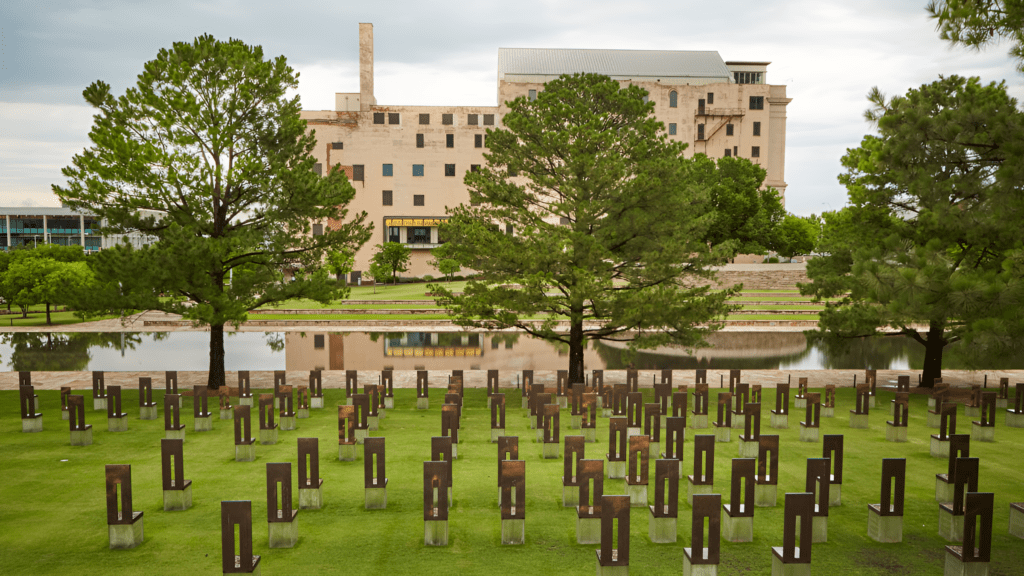The 1995 bombing is also commemorated at the Oklahoma City National Memorial, which honors the victims as well as survivors and rescuers. The attack took place on April 19, 1995, when a truck bomb exploded in front of the Alfred P. Murrah Federal Building. The attack killed 168 people, including 19 children, and injured over six hundred. The Memorial stands as a poignant reminder of the fall while celebrating strength, survival, and Community.
The Event of April 19, 1995
At 9:02 a.m., a powerful explosion ripped through downtown Oklahoma City. The bombing was in retaliation for the U.S. government by a former U.S. Army soldier, Timothy McVeigh. He parked a Ryder truck filled with explosives in front of the federal building, destroying much of it. The explosion has created a massive crater while flattening the nine-story building. Rescue workers flocked to the scene looking for survivors in the debris.
Creation of the Memorial
In the aftermath, the local and national communities united to rebuild and heal. Discussions to create a memorial began soon after the attack. Additionally, the Oklahoma City National Memorial was created to commemorate the victims and those who rescued them. Chosen from among 624 entries submitted worldwide, the memorial design was the winning vision for a space of reflection and remembrance from Hans and Torrey Butzer, working with Sven Berg.
Key Features of the Memorial
The Memorial comprises symbolic elements. The 168 are remembered at the site with a feature known as “Field of Empty Chairs.” Each chair bears the name of one of those who died and represents the floors on which they perished. Nineteen smaller chairs represent the children’s lives that were taken.
Another central element is the” Reflecting Pool,” which sits where 5th St. once ran. Just like the calm surface of water that mirrors heaven and peace. The two massive structures that mark the entrance to the pool are also “Gates of Time.” The east gate, which represents 9:01 when the bombing had not yet occurred, symbolizes innocence, and then they pass through a bridge kind of hall where there is an open area visible from both sides—the building on one side supported by walls with names of those saved behind it.
The “Survivor Tree,” an American elm that managed to live through the blast, serves as a testament to endurance. The fence ended at a part of the Memorial dedicated to this same tree, which was all but leveled after being struck by a direct number and didn’t sap again. Today, a symbol of hope and resilience for visitors to the Pavilion is its telling of survival.
The Memorial Museum
Adjacent to the outdoor Memorial, the Oklahoma City National Memorial Museum provides a more detailed overview of factors leading up to the attack as well as the direct aftermath. The museum displays are very moving—first-hand stories, artifacts, and photos. Listen to audio clips, for example, a recording of the explosion that was heard that day. The museum also highlights the investigation that led to McVeigh’s capture and trial, shedding light on how justice was pursued.
The Memorial’s Part in the Healing
The Memorial is meant to be much more than just a place of remembrance. It is a space to grieve and find solace for survivors and the families of victims. Each year, a remembrance ceremony is held on April 19 at the Memorial to mourn those lost and give strength for living that we endured as one Community. This highlights the necessity of a common front to confront such immense devastation.
Additionally, the Memorial serves as an essential educational tool for future generations. Exhibits and programs at the museum are used to educate people about extremist threats and the need for tolerance. In confronting this past, the memorial challenges visitors to reject violence and hatred in any guise.
Impact on the Community
It was a dark day, and no one living through it could forget it. The Oklahoma City bombing forever changed the city of Oklahoma, but this Memorial has turned that tragedy into hope. It is a testament to the resilience and will of the people in Oklahoma City. The attack that so easily could’ve broken the Community had left people nothing but binding hearts together in the hope of healing. The Memorial is present in the city to remind us about compassion and living as one When Disaster Comes!

